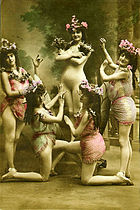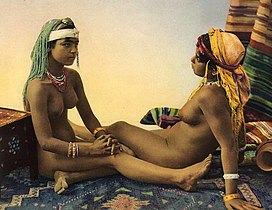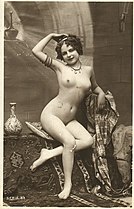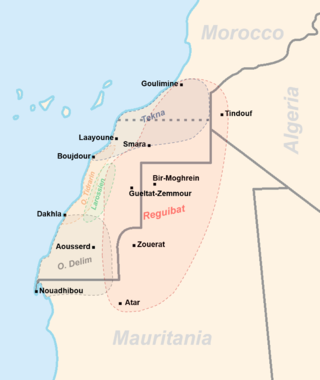
The Sahrawis, or Sahrawi people, are an ethnic group and nation native to the western part of the Sahara desert, which includes the Western Sahara, southern Morocco, much of Mauritania, and along the southwestern border of Algeria. They are of mixed Hassani Arab and Sanhaji Berber descent, as well as Sub-Saharan African and other indigenous populations.
Erotic photography is a style of art photography of an erotic, sexually suggestive or sexually provocative nature.
Depictions of nudity include all of the representations or portrayals of the unclothed human body in visual media. In a picture-making civilization, pictorial conventions continually reaffirm what is natural in human appearance, which is part of socialization. In Western societies, the contexts for depictions of nudity include information, art and pornography. Information includes both science and education. Any ambiguous image not easily fitting into one of these categories may be misinterpreted, leading to disputes. The most contentious disputes are between fine art and erotic images, which define the legal distinction of which images are permitted or prohibited.

The history of erotic depictions includes paintings, sculpture, photographs, dramatic arts, music and writings that show scenes of a sexual nature throughout time. They have been created by nearly every civilization, ancient and modern. Early cultures often associated the sexual act with supernatural forces and thus their religion is intertwined with such depictions. In Asian countries such as India, Nepal, Sri Lanka, Japan and China, representations of sex and erotic art have specific spiritual meanings within native religions. The ancient Greeks and Romans produced much art and decoration of an erotic nature, much of it integrated with their religious beliefs and cultural practices.
Boudoir photography is a photographic style featuring intimate, sensual, romantic, and sometimes erotic images of its subjects in a photographic studio, bedroom or private dressing room environment, primarily intended for the private enjoyment of the subjects and their romantic partners. It is distinct from glamour and art nude photography in that it is usually more suggestive rather than explicit in its approach to nudity and sexuality, features subjects who do not regularly model, and produces images that are not intended to be seen by a wide audience, but rather to remain under the control of the subject.

Julien Mandel was a Jewish photographer and filmmaker. He was one of the best-known commercial photographers of female nudes of the early twentieth century. He worked in Paris and his signature photography became known in the 1910s and was published through the mid-1930s by such firms as Armand Noyer, Les Studios, P-C Paris, and the Neue Photographische Gesellschaft.

Nude photography is the creation of any photograph which contains an image of a nude or semi-nude person, or an image suggestive of nudity. Nude photography is undertaken for a variety of purposes, including educational uses, commercial applications and artistic creations. The exhibition or publication of nude photographs may be controversial, more so in some cultures or countries than in others, and especially if the subject is a minor.

The Turkish Bath is an oil painting by Jean-Auguste-Dominique Ingres, initially completed between 1852 and 1859, but modified in 1862. The painting depicts a group of nude women at a pool in a harem. It has an erotic style that evokes both the Near East and earlier western styles associated with mythological subject matter. The painting expands on a number of motifs that Ingres had explored in earlier paintings, in particular The Valpinçon Bather (1808) and La Grande odalisque (1814).
Glamour photography is a genre of photography in which the subjects are portrayed in erotic poses ranging from fully clothed to nude. The term may be a euphemism for erotic photography. For glamour models, body shape and size are directly related to success.
Mary Birgitte Cecilie Magdalene Willumsen (1884–1961) was a Danish photographer who, as early as 1916, sold postcards with photographs of women in scanty clothing or nude postures taken at Copenhagen's Helgoland beach establishment. She discontinued her work when the police began to show interest in kiosks selling nude photographs. Her work is now considered to have considerable artistic value.

Women fulfilled a number of different functions during the Algerian War (1954–1962), Algeria's war for independence. The majority of Muslim women who became active participants did so on the side of the National Liberation Front (FLN). The French included some women, both Muslim and French, in their war effort, but they were not as fully integrated, nor were they charged with the same breadth of tasks as their Algerian sisters. The total number of women involved in the conflict, as determined by post-war veteran registration, is numbered at 11,000, but it is possible that this number was significantly higher due to underreporting.

Malek Alloula (1937–2015) was an Algerian poet, writer, editor, and literary critic.
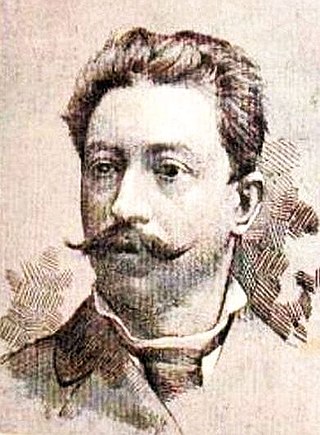
Cesare Biseo was an Italian painter, known primarily for his orientalist scenes.

Jean Agélou was a French photographer of the 1910s and 1920s, best known for his erotic and nude photographs made at the beginning of the 20th century. Agélou was born in Alexandria, Egypt, in October 1878.

Fernande Barrey was a French artist model and painter.

Arab folk dances, also referred to as Oriental dance, Middle-Eastern dance and Eastern dance, are the traditional folk dances of the Arabs in Arab world. Arab dance has many different styles, including the three main types of folklore, classical, and contemporary. It is enjoyed and implemented throughout the Arab region, from North Africa to the Middle East.

Bousbir was a walled-off brothel quarter in Casablanca, Morocco, established by Resident General Lyautey during the French protectorate.
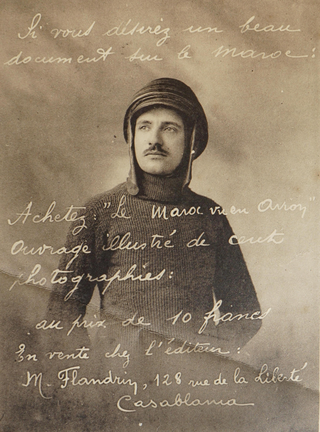
Marcelin Flandrin (1889–1957) was a French military photographer.
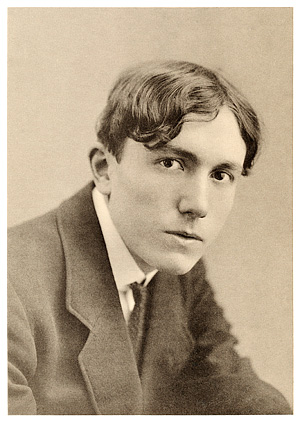
Jean Reutlinger was a French photographer.
Lehnert & Landrock was a photographic studio run by Rudolf Franz Lehnert and Ernst Heinrich Landrock active in Tunisia and Egypt in the early 20th century, noted for producing Orientalist images. Rudolf Franz Lehnert and Ernst Heinrich Landrock produced images of North African people, landscapes, and architecture for a primarily European audience. These images were mainly distributed in monographs, though also as original prints, photogravures, and lithographic postcards.






